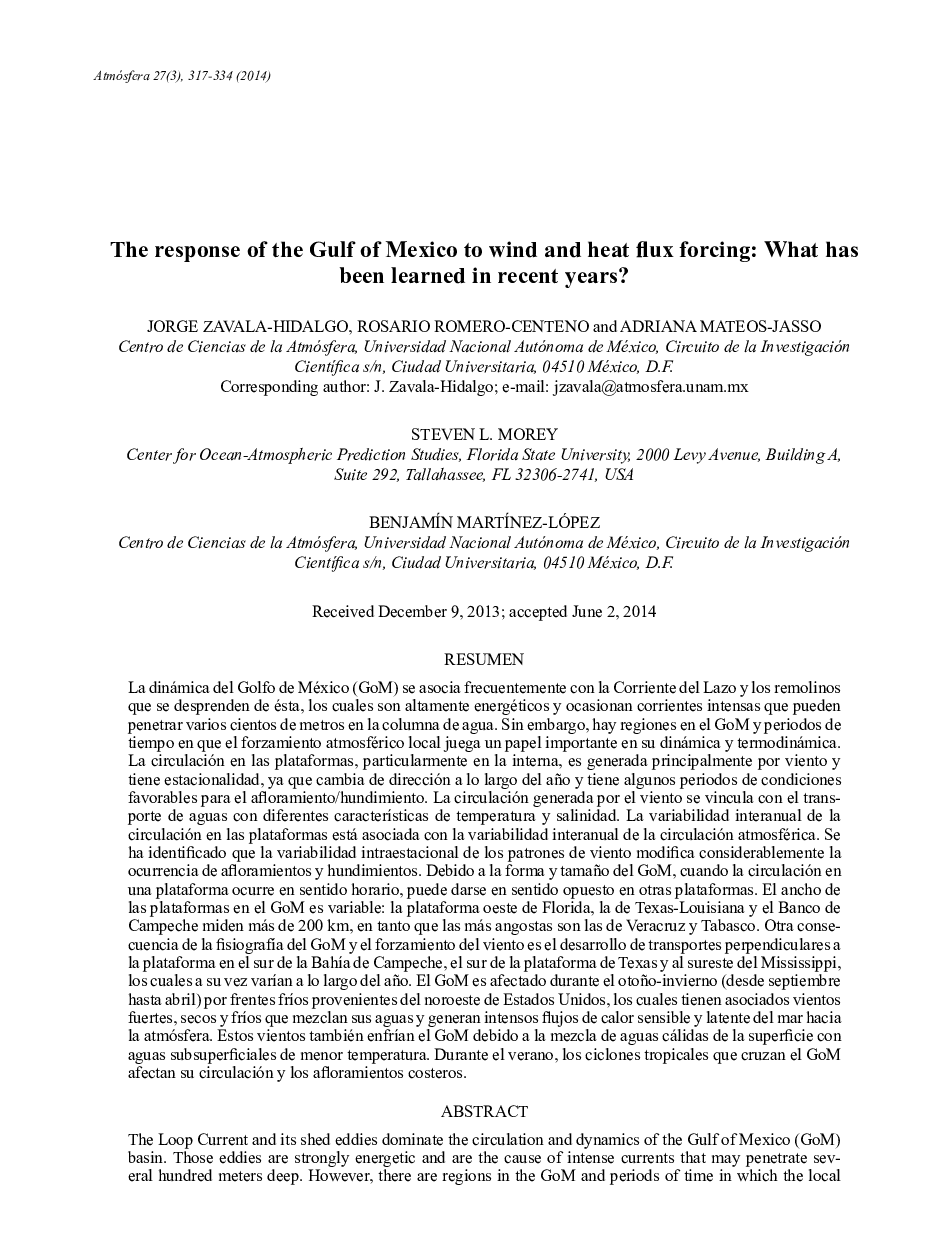| Article ID | Journal | Published Year | Pages | File Type |
|---|---|---|---|---|
| 4462024 | Atmósfera | 2014 | 18 Pages |
ResumenLa dinámica del Golfo de México (GoM) se asocia frecuentemente con la Corriente del Lazo y los remolinos que se desprenden de ésta, los cuales son altamente energéticos y ocasionan corrientes intensas que pueden penetrar varios cientos de metros en la columna de agua. Sin embargo, hay regiones en el GoM y periodos de tiempo en que el forzamiento atmosférico local juega un papel importante en su dinámica y termodinámica. La circulación en las plataformas, particularmente en la interna, es generada principalmente por viento y tiene estacionalidad, ya que cambia de dirección a lo largo del año y tiene algunos periodos de condiciones favorables para el aforamiento/hundimiento. La circulación generada por el viento se vincula con el transporte de aguas con diferentes características de temperatura y salinidad. La variabilidad interanual de la circulación en las plataformas está asociada con la variabilidad interanual de la circulación atmosférica. Se ha identificado que la variabilidad intraestacional de los patrones de viento modifica considerablemente la ocurrencia de aforamientos y hundimientos. Debido a la forma y tamaño del GoM, cuando la circulación en una plataforma ocurre en sentido horario, puede darse en sentido opuesto en otras plataformas. El ancho de las plataformas en el GoM es variable: la plataforma oeste de Florida, la de Texas-Louisiana y el Banco de Campeche miden más de 200 km, en tanto que las más angostas son las de Veracruz y Tabasco. Otra consecuencia de la fisiografía del GoM y el forzamiento del viento es el desarrollo de transportes perpendiculares a la plataforma en el sur de la Bahía de Campeche, el sur de la plataforma de Texas y al sureste del Mississippi, los cuales a su vez varían a lo largo del año. El GoM es afectado durante el otoño-invierno (desde septiembre hasta abril) por frentes fríos provenientes del noroeste de Estados Unidos, los cuales tienen asociados vientos fuertes, secos y fríos que mezclan sus aguas y generan intensos flujos de calor sensible y latente del mar hacia la atmósfera. Estos vientos también enfrían el GoM debido a la mezcla de aguas cálidas de la superficie con aguas subsuperficiales de menor temperatura. Durante el verano, los ciclones tropicales que cruzan el GoM afectan su circulación y los aforamientos costeros.
The Loop Current and its shed eddies dominate the circulation and dynamics of the Gulf of Mexico (GoM) basin. Those eddies are strongly energetic and are the cause of intense currents that may penetrate several hundred meters deep. However, there are regions in the GoM and periods of time in which the local atmospheric forcing plays an important role in its dynamics and thermodynamics. The circulation on the shelves, and particularly on the inner shelf, is mainly wind-driven with seasonality, changing direction during the year with periods of favorable upwelling/downwelling conditions. The wind-driven circulation is associated with the transport of waters with different temperature and salinity characteristics from one region to another. The interannual variability of the circulation on the shelves is linked to the atmospheric variability. Intraseasonal variability of the wind patterns considerably affects the likelihood and magnitude of upwelling and downwelling. The geometry of the GoM is such that large-scale winds may drive opposing upcoast/downcoast currents along different parts of the curving coast, resulting in convergence or divergence zones. The width of the shelves in the GoM is variable;while the West Florida Shelf, the Texas-Louisiana shelf and the Campeche Bank are more than 200 km wide, they are narrower near Veracruz and Tabasco. Another consequence of the GoM physiography and the wind forcing is the development of cross-shelf transports in the southern Bay of Campeche, the southern Texas shelf and southeast of the Mississippi river, which in turn vary during the year. During autumn-winter (from September to April), the GoM is affected by cold fronts coming from the northwest United States, which are associated with strong, dry, and cold winds that mix its waters and generate large sensible and latent heat fluxes from the ocean to the atmosphere. These frontal passages also cool the GoM surface waters due to mixing with lower temperature subsurface waters. During summer, tropical cyclones crossing the GoM can dramatically affect circulation and coastal upwelling.
